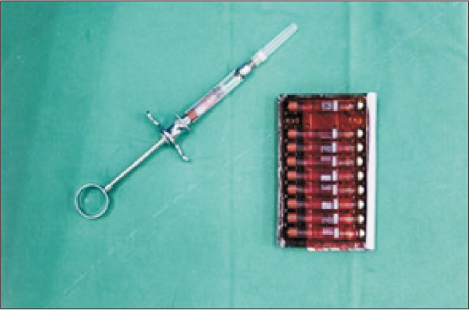Arch Hand Microsurg.
2017 Dec;22(4):233-239. 10.12790/ahm.2017.22.4.233.
Wide Awake Local Anesthesia No Tourniquet Technique for Extensor Indicis Proprius Tendon Transfer
- Affiliations
-
- 1Department of Orthopaedic Surgery, Daegu Catholic University Medical Center, Daegu, Korea. sbchae@cu.ac.kr
- KMID: 2406126
- DOI: http://doi.org/10.12790/ahm.2017.22.4.233
Abstract
- PURPOSE
To evaluate the usefulness of the Wide Awake Local Anesthesia No Tourniquet (WALANT) technique for extensor indicis proprius (EIP) tendon transfer.
METHODS
From January 2014 to January 2016. We selected the patients with chronic extensor pollicis longus rupture who underwent EIP transfer surgery with WALANT. We evaluated the patient's postoperative pain using visual analogue scale (VAS) scores, Disabilities of the Arm, Shoulder, and Hand (DASH) scores, and measured the range of motion (ROM) of the affected hand at the final follow-up session. And we compared total cost between WALANT operation and ordinary regional anesthesia.
RESULTS
There were 12 patients (4 males, 8 females) with a mean age of 57.1 years. The postoperative mean VAS score was 1.25. The mean DASH score was 17.4. The mean Metacarpophalangeal joint ROM was 56.9°, interphalangeal joint ROM was flexion 81°, extension 7.1°, and mean pinch power was 91% of unaffected side. Mean grip strength was 91% of unaffected side.
CONCLUSION
Wide-awake approach has allowed the surgeon to know how much tendon tension on tendon repair site and tendon transfer site. The wide-awake approach makes surgeon do tendon surgery much easier and more reliable.
Keyword
MeSH Terms
Figure
Reference
-
1. Jung SW, Kim CK, Ahn BW, Kim DH, Kang SH, Kang SS. Standard versus over-tensioning in the transfer of extensor indicis proprius to extensor pollicis longus for chronic rupture of the thumb extensor. J Plast Reconstr Aesthet Surg. 2014; 67:979–985.
Article2. Lalonde D, Martin A. Epinephrine in local anesthesia in finger and hand surgery: the case for wide-awake anesthesia. J Am Acad Orthop Surg. 2013; 21:443–447.
Article3. Lalonde DH, Wong A. Dosage of local anesthesia in wide awake hand surgery. J Hand Surg Am. 2013; 38:2025–2028.
Article4. Farhangkhoee H, Lalonde J, Lalonde DH. Teaching medical students and residents how to inject local anesthesia almost painlessly. Can J Plast Surg. 2012; 20:169–172.
Article5. Strazar AR, Leynes PG, Lalonde DH. Minimizing the pain of local anesthesia injection. Plast Reconstr Surg. 2013; 132:675–684.
Article6. Bezuhly M, Sparkes GL, Higgins A, Neumeister MW, Lalonde DH. Immediate thumb extension following extensor indicis proprius-to-extensor pollicis longus tendon transfer using the wide-awake approach. Plast Reconstr Surg. 2007; 119:1507–1512.
Article7. Mckee DE, Lalonde DH, Thoma A, Dickson L. Achieving the optimal epinephrine effect in wide awake hand surgery using local anesthesia without a tourniquet. Hand (N Y). 2015; 10:613–615.
Article8. Gelb RI. Tendon transfer for rupture of the extensor pollicis longus. Hand Clin. 1995; 11:411–422.
Article9. Bunnell JB. Tendon transfer surgery. Orthop Clin North Am. 1970; 1:447–454.10. Iyer S. Extensor digiti minimi transfer for thumb extension. J Plast Reconstr Aesthet Surg. 2013; 66:e264–e266.
Article11. Magnussen PA, Harvey FJ, Tonkin MA. Extensor indicis proprius transfer for rupture of the extensor pollicis longus tendon. J Bone Joint Surg Br. 1990; 72:881–883.
Article12. Lemmen MH, Schreuders TA, Stam HJ, Hovius SE. Evaluation of restoration of extensor pollicis function by transfer of the extensor indicis. J Hand Surg Br. 1999; 24:46–49.
Article13. Low CK, Pereira BP, Chao VT. Optimum tensioning position for extensor indicis to extensor pollicis longus transfer. Clin Orthop Relat Res. 2001; (388):225–232.
Article14. Denkler K. A comprehensive review of epinephrine in the finger: to do or not to do. Plast Reconstr Surg. 2001; 108:114–124.
Article15. Thomson CJ, Lalonde DH, Denkler KA, Feicht AJ. A critical look at the evidence for and against elective epinephrine use in the finger. Plast Reconstr Surg. 2007; 119:260–266.
Article16. Lalonde D, Bell M, Benoit P, Sparkes G, Denkler K, Chang P. A multicenter prospective study of 3,110 consecutive cases of elective epinephrine use in the fingers and hand: the Dalhousie Project clinical phase. J Hand Surg Am. 2005; 30:1061–1067.
Article17. Fitzcharles-Bowe C, Denkler K, Lalonde D. Finger injection with high-dose (1:1,000) epinephrine: Does it cause finger necrosis and should it be treated? Hand (N Y). 2007; 2:5–11.
Article18. Muck AE, Bebarta VS, Borys DJ, Morgan DL. Six years of epinephrine digital injections: absence of significant local or systemic effects. Ann Emerg Med. 2010; 56:270–274.
Article
- Full Text Links
- Actions
-
Cited
- CITED
-
- Close
- Share
- Similar articles
-
- Congenital Absence of Extensor Indicis Proprius Tendon, Bilateral: A Case Report
- Reconstruction of the Extensor Pollicis Longus Tendon by Tendon Graft or Tendon Transfer
- Comparison of Palmaris Longus Tendon Graft and Extensor Indicis Proprius Tendon Transfer for Reconstruction of the Extensor Pollicis Longus Tendon
- Tumescent Local Anesthesia for Hand Surgery: Improved Results, Cost Effectiveness, and Wide-Awake Patient Satisfaction
- Failed Extensor Indicis Proprius Tendon Transfer for Extensor Pollicis Longus Tendon Rupture after Distal Radial Fracture




